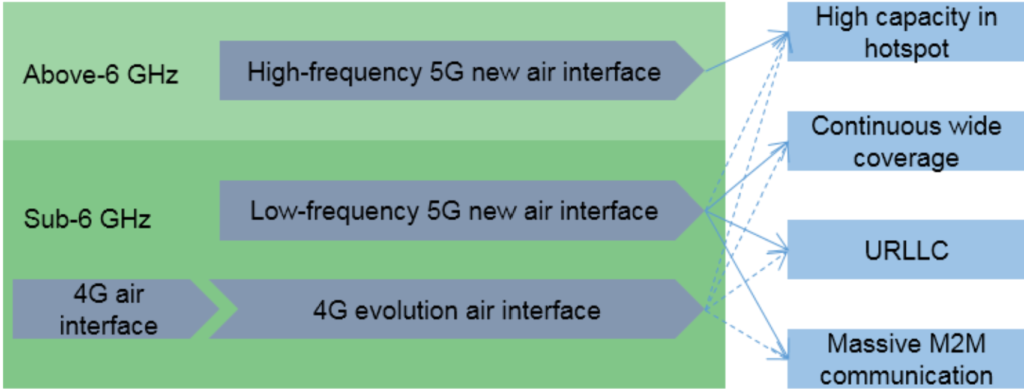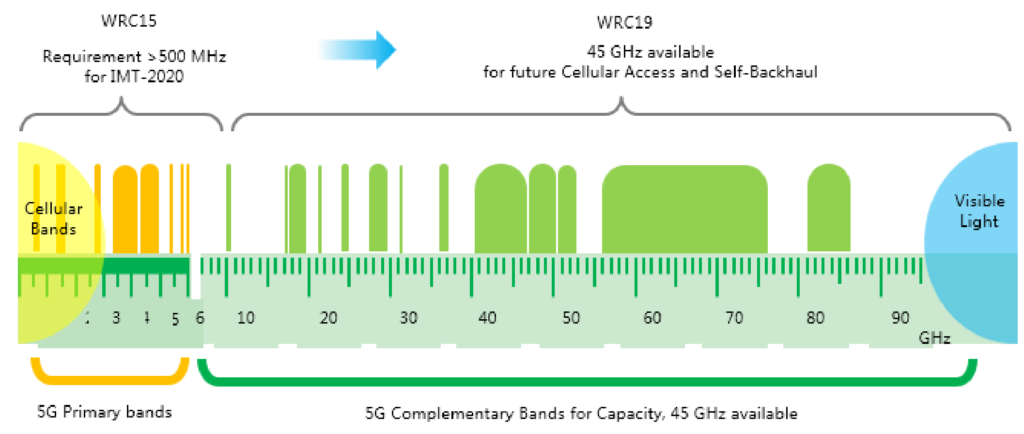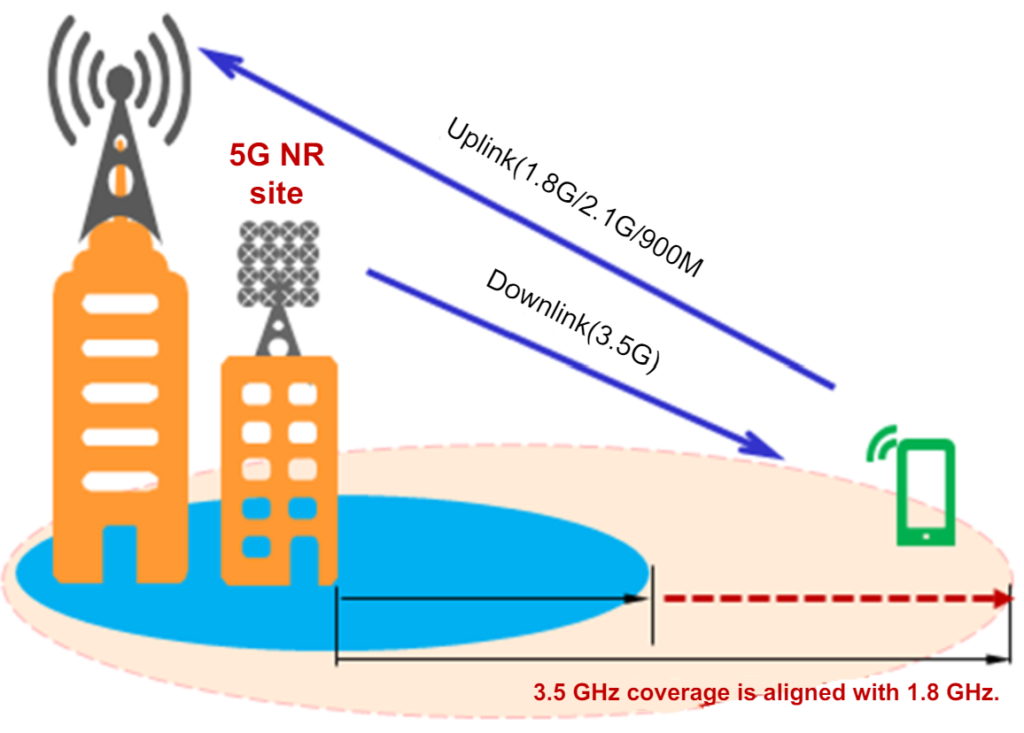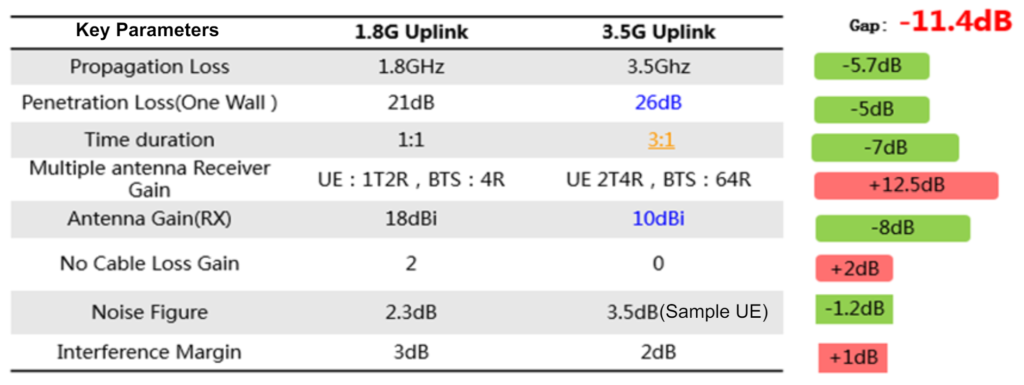The existing spectrum is insufficient to meet users’ increasing demands for higher experience rates, ultimate peak rates, massive connections, low latency, and high reliability. To address these demands, new technologies must be introduced to improve spectral efficiency, and new spectrums must be planned to cater to 5G application scenarios.
Future 5G Spectrum Architecture
The future 5G spectrum architecture will be categorized into three segments: above-6 GHz, sub-6 GHz, and the evolution of 4G/4.5G.

Each segment has unique characteristics and applications:
- Above-6 GHz: This segment supports ultra-large bandwidth, with mmWave serving as a typical high wave band. It is primarily used for high-rate requirements in hotspot areas.
- Sub-6 GHz: This segment supports a new air interface with medium and low-frequency bands. It has a strong diffraction capability, enabling continuous wide coverage, low latency, high reliability, and massive connections with low power consumption. Sub-6 GHz is the preferred frequency band for 5G.
- 4G/4.5G Evolution: This segment will integrate with 5G to provide continuous improvement and support a full-band access network.
Sub-6 GHz Spectrum
Sub-6 GHz spectrum will play a crucial role in 5G due to its balanced performance. Its strong diffraction capability ensures continuous wide coverage, low latency, high reliability, and massive connections, all while maintaining low power consumption. This makes sub-6 GHz the preferred frequency band for 5G deployment.
Above-6 GHz Spectrum
Above-6 GHz spectrum will act as a supplementary spectrum, providing continuous and high-bandwidth capabilities. It can achieve the ultimate peak rate experience of 5G, making it ideal for meeting high-rate requirements in hotspot areas. This spectrum segment includes mmWave, which is essential for delivering ultra-high-speed connections.
Current 4G Networks
Most current 4G networks are deployed below the 3 GHz frequency band. These networks provide users with ubiquitous 100 Mbit/s experience, meeting the requirements for low power consumption and large connections. This existing infrastructure will play a role in the transition to 5G, particularly in terms of co-site deployment and spectrum sharing.
5G Testing and Allocation in China
China has planned the 3.4 GHz to 3.6 GHz frequency band for 5G tests. Additionally, the Radio Management Bureau of China has allocated 399 MHz of spectrum from 3 GHz to 6 GHz for 5G, including bands such as 3.3 GHz to 3.4 GHz, 4.4 GHz to 4.5 GHz, and 4.8 GHz to 4.99 GHz. Coordination tasks are ongoing, and there is a future focus on the above-20 GHz spectrum. Spectrum allocation strategies and pace are to be determined, with industry consensus leaning towards collaboration with IMT for unified 5G spectrum allocation to strive for a win-win situation.
Global 5G Spectrum Coordination
Globally, the C-band (3.4 GHz to 4.2 GHz) is likely to be the most coordinated, providing the only 100 MHz bandwidth frequency band operators can obtain from sub-6 GHz in the next five years. Additionally:
- 28 GHz: May become a regional 5G spectrum in regions like the US, Korea, Japan, and others.
- 39 GHz and 25 GHz: Are potential global collaborative mmWave spectrums.

Uplink and Downlink Co-Coverage
To achieve the co-coverage objective of the C-band (3.5 GHz) and existing networks, NR uplink can use existing FDD frequencies, such as 1.8 GHz. This strategy leverages the relatively idle uplink spectrum of existing LTE networks to compensate for the uplink gap in higher frequencies.

Specifically:
- Lower Spectrum Compensation: The lower spectrum can cover the uplink gap, fully utilizing idle FDD spectrum resources.
- Improved Coverage: Analysis shows that the coverage of FDD PUSCH at 1.8 GHz improves by about 11 dB compared to PUSCH at 3.5 GHz.
- Co-Coverage with Existing Networks: NR downlink at 3.5 GHz and NR uplink at 1.8 GHz can achieve co-coverage with existing networks.

Uplink and Downlink Decoupling
Combining the 5G NR downlink with the LTE uplink can achieve uplink and downlink decoupling, offering several benefits:
- Region-Level Coordination: Allows effective coordination and flexible, efficient resource allocation between different RATs, frequency bands, sites, and service requirements.
- Maximized Network Efficiency: Leverages the complementary advantages of the two technologies to maximize overall network efficiency.
Final Words about 5G Spectrum.
5G requires a new spectrum architecture and improved spectral efficiency to meet user demands. The future spectrum will include above-6 GHz, sub-6 GHz, and 4G/4.5G evolutions, with sub-6 GHz being the preferred frequency band for its balance of coverage and performance. Above-6 GHz will provide high bandwidth for peak rate experiences. Global coordination, uplink and downlink decoupling, and efficient resource allocation are essential for maximizing network efficiency.